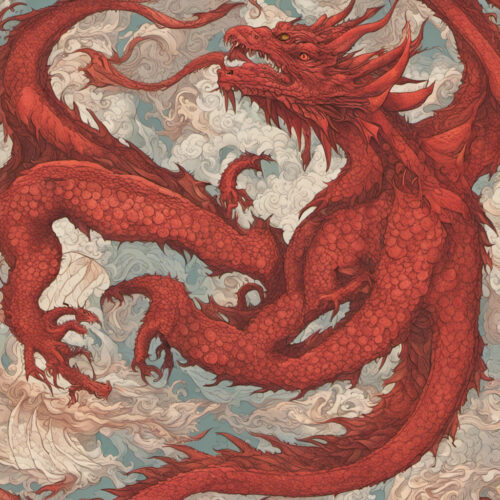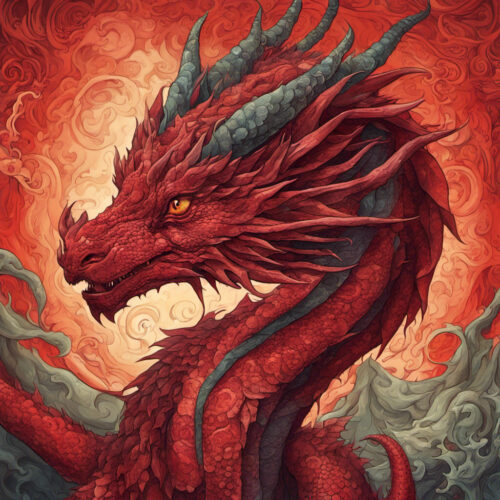The world of dragons has long captured the imagination of both young and old alike. Legends and stories have been passed down through generations, painting these mighty creatures as fierce and majestic beings. One artist who delved deep into the symbolism of dragons was William Blake, a renowned English poet and painter. In this article, we will explore the enigmatic symbolism behind Blake’s famous painting, “Red Dragon,” and shed light on the secrets of real dragons.
The Mysterious Red Dragon
William Blake’s “Red Dragon” is a captivating masterpiece that showcases his unique interpretation of dragons. The painting depicts a vibrant red Dragon, its wings spread wide as if ready to take flight. The intensity of the colors and the intricate details of the scales and claws evoke a sense of power and strength.

At first glance, the Red Dragon appears fierce and menacing. However, Blake’s symbolic representation goes beyond the surface. The dragon is often associated with wisdom, knowledge, and protection. Its red color signifies passion, fire, and transformation, suggesting that dragons possess transformative powers that can lead one towards enlightenment.
The Symbolism of Dragons
Dragons hold a significant place in various mythologies and cultures worldwide. In Western traditions, dragons are often depicted as malevolent creatures, hoarding treasures and ravaging villages. However, these representations fail to capture the complexity and symbolism behind these mythical beings.
Real dragons, according to ancient beliefs, are not merely physical creatures but embody more profound spiritual meanings. They are often associated with transformation, protection, and the pursuit of knowledge. In many cultures, dragons are revered as divine beings, with their wisdom and power harnessed for the betterment of humanity.
The Dragon’s Connection to Nature
One of the compelling aspects of dragons in Blake’s painting and in mythology is their intricate connection to nature. Dragons are often portrayed as guardians of the natural world, and in some stories, they possess the ability to control the elements. This connection symbolizes the harmonious relationship between humans and nature, emphasizing the importance of living in balance with our environment.
Dragons also embody the duality of nature itself. Just like nature can be both gentle and destructive, dragons encompass both benevolent and malevolent qualities. This duality serves as a reminder that we must respect and understand the power of nature, as it can both nurture and challenge us.
Exploring the World of Dragons
While dragons may be mythical creatures, the fascination with these powerful beings persists in modern times. Many books, movies, and games bring dragon lore to life, allowing us to explore their symbolism and charismatic allure. One such example is the critically acclaimed video game, “The Elder Scrolls V: Skyrim,” where dragons play a central role in the protagonist’s journey.
For those seeking to delve deeper into the world of dragons and expand their knowledge about mythical creatures, Dragon University offers a range of courses and resources. From the history of dragon mythology to the art of dragon summoning, Dragon University provides a treasure trove of information and insights for enthusiasts.
A Glimpse of Dragons in Pop Culture
The allure of dragons extends beyond ancient tales and artworks. Dragons have become cultural icons, making appearances in a variety of mediums, including literature, art, and music. One such example is the popular fantasy series, “A Song of Ice and Fire” by George R.R. Martin, which features majestic dragons that captivate both the characters and readers alike.
If you’re interested in exploring dragon-inspired music, check out this captivating YouTube video showcasing a mesmerizing dragon-inspired composition.
The Legacy of Dragons
The enduring legacy of dragons in human culture is a testament to their timeless appeal and symbolism. From ancient myths to modern interpretations, dragons continue to captivate our imagination, reminding us of the profound connection between humanity, nature, and the pursuit of knowledge.
As we unravel the secrets of William Blake’s “Red Dragon” and delve into the rich symbolism behind these mythical creatures, we gain a deeper understanding of ourselves and the world we inhabit.


